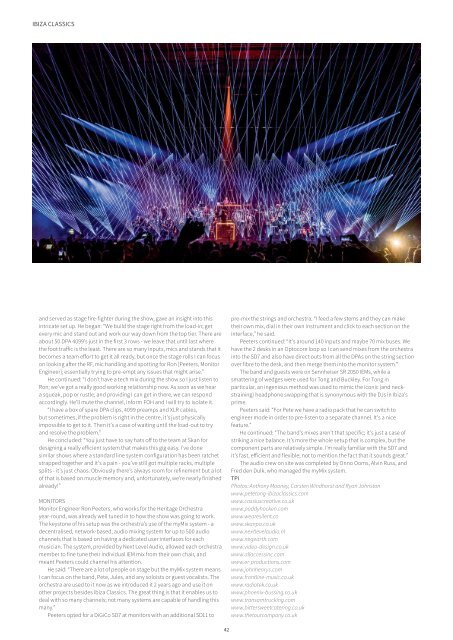You also want an ePaper? Increase the reach of your titles
YUMPU automatically turns print PDFs into web optimized ePapers that Google loves.
IBIZA CLASSICS<br />
and served as stage fire-fighter during the show, gave an insight into this<br />
intricate set up. He began: “We build the stage right from the load-in; get<br />
every mic and stand out and work our way down from the top tier. There are<br />
about 50 DPA 4099’s just in the first 3 rows - we leave that until last where<br />
the foot traffic is the least. There are so many inputs, mics and stands that it<br />
becomes a team effort to get it all ready, but once the stage rolls I can focus<br />
on looking after the RF, mic handling and spotting for Ron [Peeters, Monitor<br />
Engineer]; essentially trying to pre-empt any issues that might arise.”<br />
He continued: “I don’t have a tech mix during the show so I just listen to<br />
Ron; we’ve got a really good working relationship now. As soon as we hear<br />
a squeak, pop or rustle, and providing I can get in there, we can respond<br />
accordingly. He’ll mute the channel, inform FOH and I will try to isolate it.<br />
“I have a box of spare DPA clips, 4099 preamps and XLR cables,<br />
but sometimes, if the problem is right in the centre, it’s just physically<br />
impossible to get to it. Then it’s a case of waiting until the load-out to try<br />
and resolve the problem.”<br />
He concluded: “You just have to say hats off to the team at Skan for<br />
designing a really efficient system that makes this gig easy. I’ve done<br />
similar shows where a standard line system configuration has been ratchet<br />
strapped together and it’s a pain - you’ve still got multiple racks, multiple<br />
splits - it’s just chaos. Obviously there’s always room for refinement but a lot<br />
of that is based on muscle memory and, unfortunately, we’re nearly finished<br />
already!”<br />
MONITORS<br />
Monitor Engineer Ron Peeters, who works for the Heritage Orchestra<br />
year-round, was already well tuned in to how the show was going to work.<br />
The keystone of his setup was the orchestra’s use of the myMix system - a<br />
decentralised, network-based, audio mixing system for up to 500 audio<br />
channels that is based on having a dedicated user interfaces for each<br />
musician. The system, provided by Next Level Audio, allowed each orchestra<br />
member to fine tune their individual IEM mix from their own chair, and<br />
meant Peeters could channel his attention.<br />
He said: “There are a lot of people on stage but the myMix system means<br />
I can focus on the band, Pete, Jules, and any soloists or guest vocalists. The<br />
orchestra are used to it now as we introduced it 2 years ago and use it on<br />
other projects besides Ibiza Classics. The great thing is that it enables us to<br />
deal with so many channels; not many systems are capable of handling this<br />
many.”<br />
Peeters opted for a DiGiCo SD7 at monitors with an additional SD11 to<br />
pre-mix the strings and orchestra. “I feed a few stems and they can make<br />
their own mix, dial in their own instrument and click to each section on the<br />
interface,” he said.<br />
Peeters continued: “It’s around 140 inputs and maybe 70 mix buses. We<br />
have the 2 desks in an Optocore loop so I can send mixes from the orchestra<br />
into the SD7 and also have direct outs from all the DPAs on the string section<br />
over fibre to the desk, and then merge them into the monitor system.”<br />
The band and guests were on Sennheiser SR 2050 IEMs, while a<br />
smattering of wedges were used for Tong and Buckley. For Tong in<br />
particular, an ingenious method was used to mimic the iconic (and neckstraining)<br />
headphone swapping that is synonymous with the DJs in Ibiza’s<br />
prime.<br />
Peeters said: “For Pete we have a radio pack that he can switch to<br />
engineer mode in order to pre-listen to a separate channel. It’s a nice<br />
feature.”<br />
He continued: “The band’s mixes aren’t that specific; it’s just a case of<br />
striking a nice balance. It’s more the whole setup that is complex, but the<br />
component parts are relatively simple. I’m really familiar with the SD7 and<br />
it’s fast, efficient and flexible; not to mention the fact that it sounds great.”<br />
The audio crew on site was completed by Onno Ooms, Alvin Russ, and<br />
Fred den Dulk, who managed the myMix system.<br />
<strong>TPi</strong><br />
Photos: Anthony Mooney, Carsten Windhorst and Ryan Johnston<br />
www.petetong-ibizaclassics.com<br />
www.cassiuscreative.co.uk<br />
www.paddyhocken.com<br />
www.wearesilent.co<br />
www.skanpa.co.uk<br />
www.nextlevelaudio.nl<br />
www.negearth.com<br />
www.video-design.co.uk<br />
www.allaccessinc.com<br />
www.er-productions.com<br />
www.johnhenrys.com<br />
www.frontline-music.co.uk<br />
www.radiotek.co.uk<br />
www.phoenix-bussing.co.uk<br />
www.transamtrucking.com<br />
www.bittersweetcatering.co.uk<br />
www.thetourcompany.co.uk<br />
42


